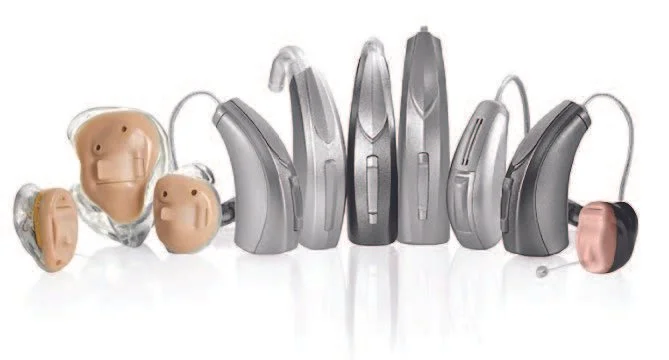Delve Into the Differences in Hearing Aids
Article by Mitch Rockwell
When exploring what hearing aid to get, there are always a lot of questions. How will wearing a hearing aid help, who will make sure they are working properly, how will it look, etc.? This is where the help of a licensed
Hearing Instrument Specialist becomes important in finding answers to these questions:
• Hearing aid choices.
• What to look for when buying a hearing aid.
• How to get used to a hearing aid.
Hearing Aid Choices
Hearing aids come in a variety of styles such as receiver in the canal (RIC), behind the ear (BTE), in the ear (ITE), in the canal (ITC), and completely in the canal (CIC), and others. All of these fi t differently and have advantages and disadvantages depending on your particular hearing needs.
There are also several different levels of technology. These are chosen depending on your hearing needs or hearing expectations. Each level of technology brings its own style and benefits such as:
Noise reduction. All hearing aids cut some noise. How much they cut it varies. Some also cut wind noise.
Directional microphones. This feature involves two or more microphones. They can pick up sound from all around or from just one direction, such as in front of you. Directional microphones can improve hearing in places with a lot of background noise, like restaurants. Rechargeable batteries. Some hearing aids have batteries the user can recharge.
Telecoils. This feature makes it easier to hear when talking on a telephone that works with telecoils. The telecoil picks up the sounds instead of the microphone.
Auracast. This is a new feature that will begin replacing Bluetooth and will be implemented similarly to telecoils, but in an easier-to-use way. Wireless connectivity. Many hearing aids work with devices that use Bluetooth. Devices include cellphones, music players, computers, and televisions.
Remote controls. Some hearing aids come with a remote control. This lets you adjust features without touching the hearing aid. Some hearing aids connect wirelessly to a cellphone and have an app that allows use of the phone as a remote control.
Variable programming. Some hearing aids can store settings you program ahead of time for certain listening needs.
Synchronization. If you wear two hearing aids, this feature makes them work together. So if you change the volume or the program for one hearing aid, you also change the other hearing aid.
When looking for a hearing aid ask your Hearing Instrument Specialist as many questions as possible. Make a list of the things you want to achieve with your hearing aids and the things you feel you hear well and what areas are troublesome.
To do well with hearing aids, wear them often and take good care of them.

